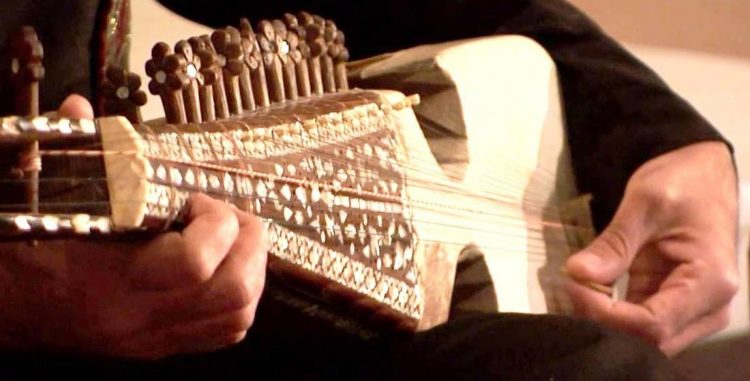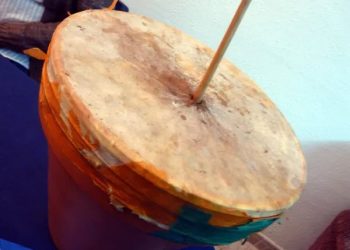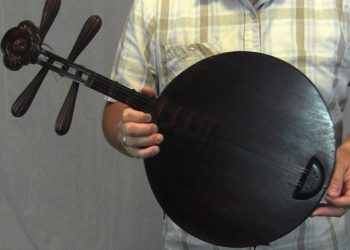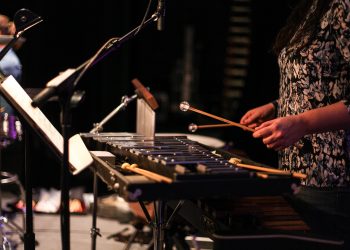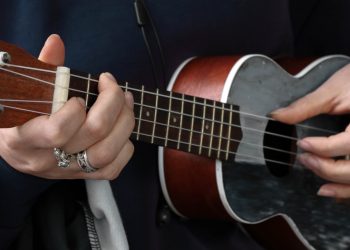Music is a universal language that brings people together from all over the world, and the diversity of musical instruments is one of the many reasons why. With so many instruments to choose from, it’s easy to get lost in the variety of sounds and styles. However, in this article, we’ll be exploring a particular subset of instruments that all have something in common: they all start with the letter R.
From the rhythmic percussion of the riqq to the haunting melodies of the recorder, the instruments on this list showcase the incredible range of sounds and techniques that can be found in music. Whether you’re a musician yourself, a music enthusiast, or simply curious about the different types of instruments out there, this list will introduce you to 13 unique instruments that all have their own special place in the world of music.
Some of these instruments may be well-known and popular, while others may be less familiar or even obscure. However, each one has a rich history and culture behind it, and each offers something unique to the world of music. So, join us as we explore the top 13 musical instruments that start with the letter R and discover the incredible sounds that they can produce.
1. Rabab
The Rabab is an ancient stringed instrument that has been around for centuries. It originated in Afghanistan and was used by the local people as a form of entertainment. The Rabab typically consists of two strings, one main string and one sympathetic string, attached to a wooden neck with fingerboard and tuning pegs. The sound produced from this instrument is both mellow and deep, making it perfect for traditional music styles like Afghani Folk Music and Pashto Ghazals.
This musical instrument is often thought of as being difficult to play due to its complicated construction; however, with practice, anyone can learn how to make beautiful melodies on the Rabab! To produce the desired sound, musicians must use their fingers to pluck or strum the strings while simultaneously moving them up and down the length of the fretboard. Additionally, they must be careful not to press too hard against the strings so as not to damage them. With these techniques mastered, players are able to create unique sounds that add variety to any performance.
Though small in size compared to other instruments such as guitars or violins, the Rabab still produces powerful notes when played correctly. Its popularity continues today in countries all across Asia where traditional folk music remains popular amongst locals and tourists alike. Some modern adaptations even exist which include additional features such as electric pickups or amplified speakers – allowing musicians to experiment with new sounds without sacrificing traditionality.
In short, whether you’re looking for something traditional or something more contemporary – if you want great sounding music then look no further than the Rabab! This remarkable instrument will bring life into any song and provide hours upon hours of enjoyment for those willing explore its intricacies.
2. Rag Dung
The Rag Dung is a traditional wind instrument of Tibet and Nepal. It has been around for centuries, but its popularity continues to this day due to its unique sound. Unlike the Rabab, which produces notes through plucking or strumming strings, the Rag Dung creates music by blowing air into it. This allows players to create different sounds using various techniques such as vibrato and overblowing. Additionally, because of its small size and portability, the Rag Dung can be played in any location – making it perfect for outdoor performances!
Unlike other instruments that require extensive practice before they can produce beautiful melodies, playing the Rag Dung requires minimal effort. All one needs to do is blow into the reed at varying strengths whilst changing their angle of attack on the mouthpiece; with these simple adjustments anyone can make amazing tunes within minutes! Similarly, many complex harmonies are achievable without having to learn complicated scales or chords – allowing even beginners to sound like professionals.
As well as providing an easy way for people to enjoy music-making, the Rag Dung also has therapeutic benefits too. Playing it encourages mindfulness and relaxation; something that’s increasingly important in our busy lives today. Furthermore, the use of circular breathing (a technique where you inhale while continuing to play) helps improve lung capacity which is great for those suffering from respiratory diseases or asthma.
In short, no matter if you’re looking for entertainment or therapeutic relief – whatever your skill level may be – there’s no denying that the Rag Dung offers something special! With just a few breaths you can instantly transform any setting into a musical wonderland full of joyous tunes and delightful harmonies!
3. Rainstick
Building on the therapeutic and entertainment value of wind instruments, we come to a unique instrument that has been around for centuries: The Rainstick.
Unlike the Rag Dung which produces music through air being blown into it, the Rainstick creates soft sounds resembling raindrops by having pebbles or beads fall down inside its hollow body when you tilt it back and forth. This gentle rhythm is both calming and mesmerizing – making it perfect for relaxation or meditation.
The construction of a Rainstick can vary greatly depending on region; some are made with bamboo while others use metal pipes filled with dried beans. Additionally, they often have visual decorations such as shells or feathers attached to them too! Furthermore, because these instruments are relatively simple to make – many communities create their own versions using materials found locally – thus giving each one a distinct character.
Another great thing about this instrument is its potential in musical performances; due to its size it’s ideal for outdoor events where other larger instruments might not be suitable. It also pairs nicely with stringed ones like guitar or ukulele– allowing musicians to experiment more freely without worrying about overpowering each other’s sound. With just minimal practice anyone can easily produce complex interludes full of beautiful melodies!
All things considered, the Rainstick is an incredibly versatile instrument that works wonderfully as either background music or part of an entire ensemble performance. Its subtle yet captivating tones invoke feelings of calmness within us all – providing us with moments of peace amidst our chaotic lives.
4. Rajão
Moving on from the tranquil sounds of the Rainstick, we come to a percussive instrument that is sure to get your feet tapping: The Rajão.
This stringed instrument originated in Portugal but has since spread all over the world due to its unique sound and ease of use. It’s made up of a wooden box with strings stretched across it – similar to an upright bass or guitar – and comes in different sizes depending on how loud you want it to be.
The distinctive feature of this instrument is its ability to produce rapid-fire notes when played; by plucking one or more strings at once musicians can create intricate rhythms and melodies that are both impressive and fun! Additionally, because it’s small enough to carry around it makes for great accompaniment while traveling as well.
However, what really sets the Rajão apart is not just its versatility but also its potential for experimentation; players can experiment with new techniques such as strumming chords or using their fingers instead of a pick – allowing them to explore various genres including folk music, rock music, jazz – even classical pieces have been arranged for this instrument too!
In short, the Rajão provides endless possibilities for creative expression whether you’re playing alone or with others. Its upbeat tempo will surely make any gathering much livelier whilst providing hours of entertainment – making it essential part of many musical performances today.
5. Rattle
The rattle is another essential percussion instrument that can be found in many different styles of music. It’s a handheld tool made up of two sticks connected by a string and usually filled with small objects like beads, stones or coins which make a sound when shaken. This simple but effective design has been around for centuries; it’s believed to date back as far as Ancient Egypt!
Rattles are great for creating energetic rhythms – the player controls the speed and intensity depending on how they shake them – while their light weight makes them easy to transport from place to place. Plus, if you want something more unique than the standard rattling noise, then there are plenty of options available such as plastic models with built-in bells or shakers with adjustable tone settings. In addition, some people even prefer making their own rattles out of everyday materials at home!
When playing live, rattles add an extra layer of excitement thanks to their interactive nature – everyone loves shaking along with the beat! They also work well when layered over other instruments during recording sessions too, adding texture and depth to your mix. And finally, most musicians agree that having a rattle handy will serve you well no matter what type of performance you’re putting together – from intimate acoustic jams through to full-on rock concerts.
No matter what kind of music you’re into, incorporating a rattle into your setup is sure to take your sound to the next level. Whether you choose store-bought versions or create something special using items found around your house, this versatile instrument offers endless possibilities for any musician looking for something fun and creative!
6. Rebec
The next musical instrument to explore is the Rebec. This bowed stringed instrument has a long history of providing accompaniment and melodic lines for various styles of music, from jazz to classical. It features an asymmetrical pear-shaped body with three strings which are played by drawing a horsehair bow across them.
The sound produced by this beautiful instrument is captivating – its timbre varies depending on how it’s held and what type of bowing technique is used. Unlike other bowed instruments such as violins or cellos, the Rebec is much smaller so it’s easier to transport and can be ideal for impromptu performances in more intimate settings. Additionally, players have plenty of freedom when exploring different tones and sounds due to the ease at which they can move their hands around the fingerboard.
In addition to being incredibly versatile, the Rebec also offers musicians lots of opportunities for improvisation thanks to its unique design; you don’t need any kind of complex chords or scales in order to create interesting melodies! As well as having high potential for experimentation, this particular instrument produces some really warm vibrating overtones that will really bring your compositions alive.
Whether you’re looking for something special to add texture or simply want a new soundscape altogether, introducing a Rebec into your setup could be just what you need. With its versatility and portability, there’s no doubt that it’ll provide endless possibilities both live and in the studio!
7. Reco-Reco
Building on the unique sound created by bowed string instruments, let’s explore another one: the Reco-Reco. This percussion instrument is made up of a hollowed-out log that has been cut and shaped in such a way to create ridges along its length. These ridges vibrate when scraped with a stick or other object, creating an incredibly distinct soundscape.
The distinctive timbre of this traditional Brazilian instrument makes it perfect for adding texture to any kind of music – be it jazz, pop, rock, classical or even experimental! Plus, because of its size and portability you can easily take your Reco-Reco anywhere you go. Whether you want to use it as part of a live performance or record something special in the studio, this instrument will provide plenty of opportunities for exploration.
One great thing about playing the Reco-Reco is how quickly players can come up with interesting rhythms and patterns; all you need are some basic coordination skills. It’s also an excellent tool for learning new techniques since there isn’t much pressure involved when making mistakes – unlike more complex instruments such as drums that require precision timing and accuracy from their player.
Despite being relatively easy to get into, mastering the artistry behind this instrument takes plenty of practice and dedication – which is why it remains so popular among professional musicians today! With its ability to bring life and depth to any musical arrangement, introducing a little bit (or a lot) of Reco-Reco could really help set your compositions apart from others.
8. Recorder
Building on the sound of traditional Brazilian percussion, let’s turn our attention to another popular musical instrument: the recorder. This flute-like instrument has been around for centuries and is still beloved by musicians from all over the world today. Its simple design makes it incredibly accessible for beginners, yet there are plenty of techniques that can be developed as players become more proficient.
The recorder produces a sweet, gentle tone that adds warmth to any ensemble or solo piece. It also offers up an array of opportunities for improvisation in both classical and contemporary settings – allowing artists to express themselves freely while adding depth and complexity to their arrangements. Plus, because they’re so affordable you don’t have to break the bank if you want to get your hands on one!
Playing the recorder requires some basic technique; mastering breath control and finger dexterity will take practice but will ultimately result in richer tones and greater consistency throughout your performances. As with other instruments like guitar or drums, learning songs off by heart can help develop muscle memory which leads to smoother transitions when playing live or recording in the studio.
Whether you’re just starting out or already consider yourself a pro, introducing this versatile instrument into your repertoire could make all the difference – creating new possibilities for sonic exploration along the way! With its affordability and easy accessibility combined with its unique timbre, few things compare to experiencing music through a recorder first hand.
9. Repinique
The repinique is another important instrument often used in Brazilian music. It’s a large, two-headed drum which can be played with sticks or hands – making it incredibly versatile and adaptable to different styles of music. Its deep, loud sound has been employed for centuries by street bands, carnival groups and traditional ensembles alike – providing the backbone for many popular rhythms.
Playing the repinique requires some skill and knowledge of technique as well as good coordination between your hands and feet. You’ll need to learn basic techniques such as rimshots, rolls and flams to get started but once you have these down pat there are plenty of opportunities for improvisation! Additionally, mastering syncopated rhythms like samba can help you stand out from other players and add more excitement to your performance.
Despite its size, this powerful drum is surprisingly portable and perfect for taking on gigs or practice sessions wherever you go. With proper care you won’t ever have to worry about missing an opportunity because you don’t have access to a full drum set! Plus, learning how to tune it correctly will ensure that each hit sounds just right no matter where or when you’re playing it.
Whether it’s solo performances or part of larger ensembles, the possibilities are endless with the repinique – allowing musicians to explore new depths of creativity while pushing their skills further than ever before. So if you’re looking for something unique yet highly expressive then this dynamic instrument could be exactly what you need!
10. Requinto
The requinto is a smaller drum than the repinique and has its own unique sound. It’s usually tuned higher to create a sharper, more cutting tone which can be heard above other instruments in an ensemble. This makes it well-suited for playing complex rhythms such as bossa nova or samba along with providing a counterpoint to louder percussion instruments like the surdo. It also features prominently in Afro-Brazilian music thanks to its ability to keep up with fast tempos while still retaining clarity.
In addition to traditional Brazilian styles, the requinto has been used in many different genres of music over time – including jazz, rock, pop and even electronic dance music! Its versatility means that you could use it just about anywhere – from live performances on stage to recording sessions in the studio. As long as you have your sticks handy you’ll always have access to this powerful source of expression.
Achieving the perfect sound on the requinto isn’t easy however; mastering techniques like ghost notes and flams requires practice and concentration if you want your performance to stand out. You may need some guidance at first but once you get comfortable with these concepts then there are plenty of opportunities for creativity within reach!
No matter what genre of music you’re into, learning how to play the requinto will give you a new appreciation for rhythm and tempo – allowing you to explore new sounds while pushing yourself further musically. With enough dedication, who knows what kind of amazing things you’ll be able to do?
11. Riq
The riq is a small hand-held frame drum originating from the Middle East. It has become an integral part of traditional Arabic music and can be found in many different cultures around the world. The instrument consists of a wooden frame with metal rings, which are struck by beaters to produce its distinct sound. Despite its size, it produces loud tones that allow it to cut through other instruments and create a powerful presence in any ensemble.
Due to its adaptability and easy portability, this unique percussion instrument has been adopted into various genres of modern music including pop, rock, jazz, hip-hop and electronic dance music – making it perfect for live performances or studio recordings. Experienced musicians will often use techniques such as ghost notes and flams when playing on the riq to achieve greater expression but it’s also very accessible even for beginners!
Playing the riq requires patience and dedication since mastering complex rhythms takes time. But once you’ve got your bearings there’s no limit to what kind of sounds you can draw out from this fascinating instrument. From pulsating grooves to intricate melodies – learning how to play the riq will bring out your musical creativity like never before!
You don’t need expensive equipment or extraordinary skills; all you need is passion and determination to get started exploring the possibilities available with this incredible instrument. So go ahead – pick up those sticks and start creating something truly special!
12. Rolmo
The rolmo is another traditional percussion instrument that has been used in Arabic music for centuries. It’s a hand-held drum with two heads, one deep and one shallow. The frames are usually made of wood or metal and the skins can be either synthetic or animal hide depending on the desired sound. The deeper head produces low tones while the higher head brings out brighter notes – creating an interesting contrast between high and low frequencies.
One of the greatest advantages of playing this instrument is its versatility; it can be played solo as well as part of an ensemble to provide accompaniment for more intricate melodies. Rolmos are often used in ensembles with other drums such as tablas, darbukas, doumbeks and frame drums to create complex rhythms. They’re also popular among jazz musicians due to their ability to produce subtle nuances when struck lightly.
Playing the rolmo requires skill and precision but once you’ve mastered basic techniques like back beats and flams, you’ll be able to explore a whole new realm of possibilities within your own unique style. This fascinating instrument allows for endless improvisation so don’t be afraid to experiment! With enough practice, anyone can learn how to truly make their mark on this captivating instrument – turning simple rhythm patterns into something magical!
From rumbling basslines to shimmering overtones – learning how to play the rolmo will open up a world of creativity waiting just a few beats away. So pick up those sticks and start discovering what musical treasures await you!
13. Roman Tuba
Having established the unique sounds of one percussion instrument, we now turn our attention to another: the Roman tuba. This ancient wind instrument has a long and rich history, having been used in classical music for centuries. Modern versions are crafted from brass or bronze which produces a warm, mellow tone when blown into. The shape is like that of a horn with two loops at the end – allowing it to be held comfortably while playing.
The sound of this incredible instrument can range from hauntingly beautiful melodies to powerful fanfares depending on how hard you blow into it and where your finger holes are placed across its length. It’s also incredibly versatile as both single notes and chords can be produced by adjusting the pressure of each fingertip along its body. This makes it ideal for accompanying traditional pieces or creating new compositions entirely!
Perhaps most appealing about this fascinating musical tool is its ability to add depth and texture to any ensemble; whether you’re looking to create soothing soundscapes or driving rhythms, there’s no doubt that the Roman tuba will provide exactly what you need. Plus, practice makes perfect – so why not challenge yourself by learning some classic tunes? You’ll soon find out just how much potential this timeless instrument holds!
From captivating solos to intricate accompaniments, adding the Roman tuba to your repertoire will open up endless possibilities – let those fingers fly and discover all that music has to offer!
